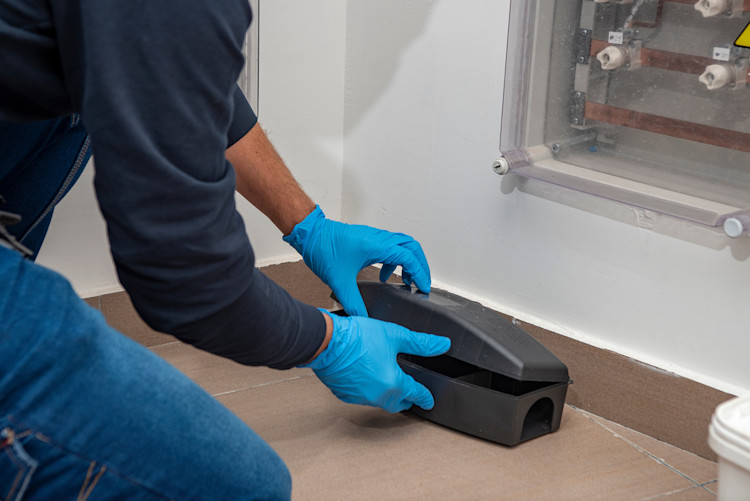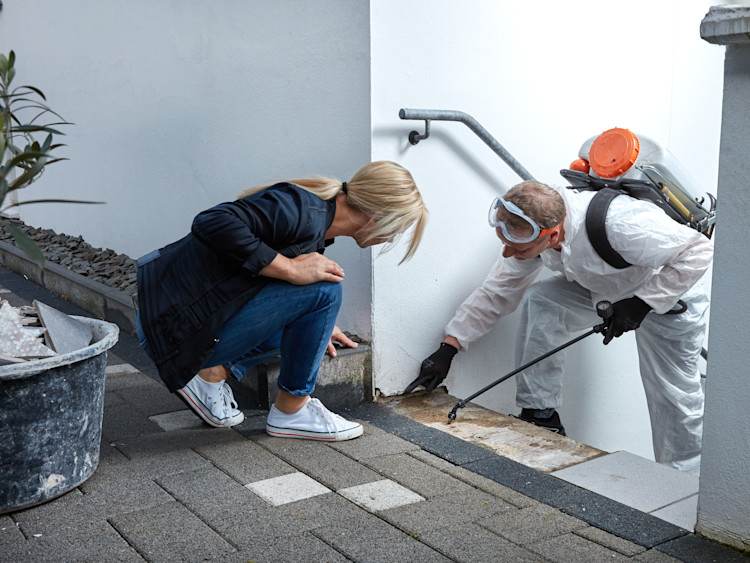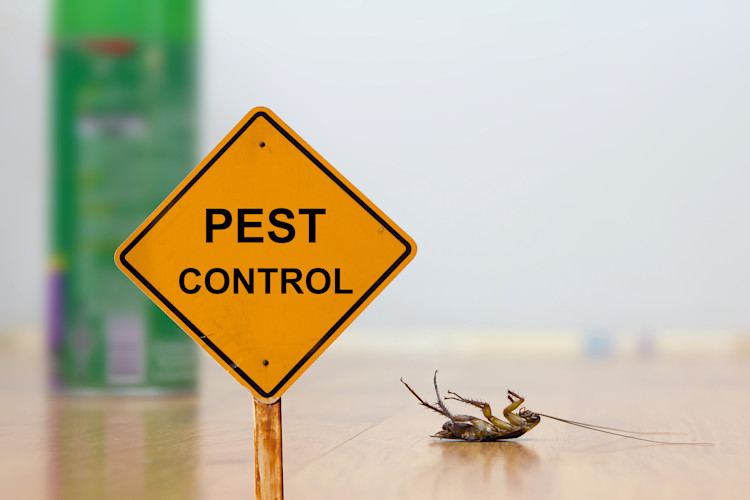Find a Pest Controller near you
The average rating for Bark Pest Controllers is 4.86, based on 122,458 reviews
Need to get rid of some pesky critters but aren’t sure of the cost? Read our handy guide to find out how much pest control will cost depending on the type and size of the infestation.
The average price of pest control is £200. This cost varies based on the type of pest, the scale of the infestation, and the method of treatment that your controller opts for.
There’s no doubt that pest control is a much-needed service across the UK. In a recent calendar year, the industry grew by 3.3%, with the most common infestations being flies, rats and wasps. Depending on the situation, your pest controller could recommend several methods, including:
Traps
Fumigation
Destroying nests
Blocking holes
Changing temperature
Chemicals
Research by Compare The Market found that 72% of people in the UK have experienced some form of pest in their property before. So, when the time arises, it’s essential that you don’t pay over the odds for this service.
If you want to find out how much pest control costs, you’re in the right place. Just remember that all figures listed on this page are based on our data and research. If you want a personalised quotation, get in touch with a pest control expert near you.

Across the UK, there’s dozens of different pests that could potentially find their way into your home. The type of pest has a big impact on the best way to remove them, along with the price you’ll pay.
Ant pest control costs £125 on average. This job is made slightly more difficult due to their small size, making it challenging to remove them completely.
Bed bugs are another common example. This is around £80 to get rid of from your house. Meanwhile, cockroach pest control is priced at £200, and rats cost roughly £275 to get rid of.
Flies and wasps are two of the more common examples of pest found in a UK household. The former costs £130 to remove, while wasps come in at around £100.
There’s plenty more pests that’re extremely common in the UK. For example, one of the most severe pests is woodworm, who can have an extremely detrimental impact on your property. This pushes the price of pest control much higher.
We’ve outlined all the average prices in the table below. If you need guidance on a pest that isn’t listed, you should speak to your pest controller for a personalised quotation.

Almost all homeowners agree that pest control is worth the money. When you know that there’s an insect or animal living in your house, it’s extremely unsettling. You might not feel comfortable living there, and it can destroy plans to sell your property or invite friends over.
However, you still don’t want to pay too much for pest control. It’s thus useful to know all the factors that impact price. These include:
Type of pest
Scale of infestation
Method of treatment
Size of your property
Pest control expert
You should keep a close eye on all of these elements. Remember that each pest controller charges in a different way, and the best way to find a suitable price is to gather several independent quotations.
There’s a wide variety of pests that homeowners have to deal with. We’ve listed the most common ones further above on the page – but some others include beetles, crickets, bees and earwigs.
Naturally, every type of pest needs a slightly different removal method. For example, with rats and mice, you’ll need to find their entry point, as well as lay traps and block up any gaps in your walls. With other pests, the treatment could be chemical-based or fumigation.
The least expensive pests to remove are bed bugs, ants and wasps. On the other side of the spectrum, woodworm and rats are undoubtedly the priciest to remove. Some woodworm can live up to 10 years, so the potential for damage is huge.
Once you spot a pest issue, try to deal with it as soon as possible. Otherwise, the problem can become much worse over time, and this pushes your price up significantly.
Some of the worst infestations often occur with abandoned properties. If no one’s been living there for several months, the number of pests inside the wall can become extensive.
Plus, if the pest has damaged your property, fixing this will also be an additional cost to take care of.
The Natural History Museum suggests that beetles, moths and bed bugs are three of the most common pests found in the UK. But how does this vary across each country?
There are six extremely common methods of treatment used by pest controllers in the UK. The most suitable one depends on the pest itself, along with the scale of the infestation. The average price for each method of treatment is as follows:
Traps – £100 per visit
Fumigation – £225 per visit
Destroying nests – £75 per nest
Blocking holes – £75
Changing temperature – £200
Chemicals – £200
Your pest controller can advise on the best method of treatment, depending on your situation. Some pests are extremely challenging to permanently remove, due to the number of eggs they lay in your house. But others can be exterminated with a simple network of traps.
Implementing these changes and then monitoring progress is often part of the service. That’s why many pest controllers make repeat visits, as one visit is rarely enough.
When pests are spread over a huge area, it inevitably costs much more. Your pest controller will visit your house to give their expert opinion on where precisely the pests are. If it’s across the entire house, the cost stretches way into the hundreds. But if it’s focused on one small corner of the property, it’s far less expensive.
Unfortunately, pest infestations are not exclusive to residential houses: you can get them in commercial buildings, too. This can push the cost significantly higher. Our average figures listed throughout this page don’t account for this.
Every expert charges for their services in a different way – and pest controllers are no different. You should ask for a no-obligation quotation on getting the problem sorted. Just keep in mind that some professionals expect call-out-fees, even if you don’t hire them, so check whether that’s the case.
Plenty of pest controllers charge by square footage. Others do it by the number of traps needed. And you’ll find some who charge per visit, meaning that if it stretches over several weeks, your cost can go much higher.
| Method of pest control | Average price |
| Traps | £100 per visit |
| Fumigation | £225 |
| Destroying nests | £75 per visit |
| Blocking holes | £75 |
| Changing temperature | £200 |
| Chemicals | £200 |

The Natural History Museum suggests that beetles, moths and bed bugs are three of the most common pests found in the UK. But how does this vary across each country?
In England, a rodent known as Glis Glis is common in the home counties, but not many other places. This is because the non-native animal was imported to Tring in 1902, and has remained in the area ever since. Meanwhile, the area with the highest concentration of mice is London.
In Wales, cluster flies are probably the most common type of fly infestation, and fleas are known to be found in houses in Wales, too. Bed bugs and black ants are common, although these appear in almost all countries across the UK.
In the highlands of Scotland, you come across ‘highland midges’, which are seen all around and can sometimes get into your house. Rabbits can be a problem in this part of Scotland too, as they weaken the ground surrounding your property’s foundations, and thus cause subsidence. Other common pests are cockroaches, rodents and even some birds.
Across the Irish Sea into Northern Ireland, homeowners sometimes have to contend with mice and rats. Flies, spiders and ants can cause a nuisance in your home too. Most of these are found in all countries across the UK.
Your house is far less valuable when pests are living inside. A buyer will have to spend money on bringing in a pest controller to fix the situation. They also run the risk of pests damaging their furniture, curtains, and foundations in the meantime.
If your house has a pest infestation when you sell, buyers drop their price by at least 5%. This is a best-case scenario, assuming no damage has been done to the house itself. Most buyers will make a condition of the sale that you fix the infestation before you proceed.
If the pests have already done damage to your property, the decrease in value will be far more than 5%. Damage to your foundations will often knock at least 20% of the price. And if there’s damage to your wiring, insulation, gutters or roof, your house will be 10% less valuable minimum.
Some cash buying companies will buy a house in any condition. But these organisations are known to offer between 15% to 20% less than the ‘typical’ market value.
For all these reasons, it’s better to hire a pest controller to fix your problem. You should get an independent quotation from a property expert near you for a customised figure.

It depends on the situation. Supermarkets and stores sell the equipment you need to manage pest control yourself. This includes traps, chemicals, and pesticides designed for fumigation.
Most experts suggest that you don’t try to set these traps up without the support of an expert. With traps, it’s extremely easy to seriously injure yourself. The same applies with chemicals if you don’t apply them in the right way, taking protective measures.
Even once you’ve applied pest control measures yourself, it’s not always easy to see if it’s permanently fixed. That’s because it’s difficult to know the full scale of the problem – which is something a pest controller can be clear about. This means when you decide to sell your house, a survey may reveal a major pest infestation that you were unaware of. This often sours relationships with your buyer, if you haven’t revealed this to them.
You should get guidance and support from an expert at every stage of your pest control journey.
Spending money on pest removal is essential though to prevent your furniture, foundations, walls and pipes from getting damaged. It’s almost always more expensive long-term if you ignore the issue.
Pest control also provides essential peace of mind. Many people find it impossible to relax when they know that pests are somewhere inside their property. You might be especially nervous if you’ve got young children and are worried about pests that carry disease.
You should always bring in an expert if you suspect you’ve got a pest problem. An expert’s opinion is essential to guiding you in fixing it permanently.
You should always bring in an expert to determine if you’ve got pests in your house. But if you’re looked for tell-tale signs, here’s a few examples.
Droppings are a common example. You might find these in dark places such as cupboards, your loft, or the basement.
Unusual noises are another indicator. With Glis Glis, you’ll sometimes hear scratching in the roof. And if you hear scurrying or gnawing, it’s worth checking it out.
A few more signs include deterioration of wood or furniture; bites or rashes; and spotting pests during the daytime.
You should hire a pest controller who is registered with a relevant authority or independent body. Examples include the British Pest Control Association (BPCA) and the National Pest Technicians Association.
Speak to your pest controller about how they intend to deal with the infestation. Which method will they use, and how can they ensure it isn’t too extreme? Sometimes, you have no choice but to pursue a method that’s harmful to the pest. It’s the only way to get them out of your house.
Animal rights bodies can advise on the best methods, and a reputable pest controller will use this to inform all their decisions.
In most cases, no. Pests such as bed bugs, rats, wasps and flies are likely to stay in your property if they’ve found a ‘safe’ place to reside. This is often the darkest and quietest crevices, such as a cupboard or a basement.
It’s always advisable to bring in a pest controller. If they feel no action is needed, they’ll tell you. But usually, it needs some intervention.
The average rating for Bark Pest Controllers is 4.86, based on 122,458 reviews